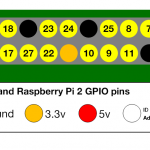So at this point I assume that you already figured that you most likely need to run some Python code on this device, but how do you turn this into something useful?
If you start researching for some simple projects to do, you will find that most has to be done via the GPIO pins and a Breadboard. A Breadboard is a board where you can plug electronic components in. This removes the need for soldering.
You will use the GPIO pins as the connections between the Raspberry Pi and the Breadboard.
So how do the GPIO pins then work? What I found is that you can use them to either collect data or to output 3,3 V or not.
For me this meant I could build my first real project, which was a temperature gauge for brewing beer.
I could find a project that somebody already did, but wanted some visual indications besides just having the code to output the temperature. This enabled me to use both the data input function of the GPIO, but also the control of a 3,3 Volt current turn control if a LED was lighting up or not. Project documentation : http://www.silenthunter.dk/?page_id=661





